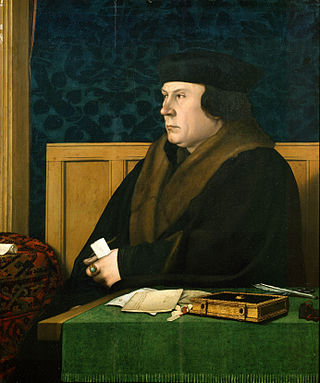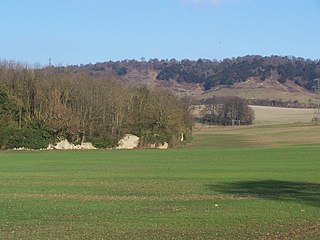Related Research Articles

Thomas Cromwell, briefly Earl of Essex, was an English lawyer and statesman who served as chief minister to King Henry VIII from 1534 to 1540, when he was beheaded on orders of the king, who later blamed false charges for the execution.

Reginald Pole was an English cardinal of the Catholic Church and the last Catholic archbishop of Canterbury, holding the office from 1556 to 1558, during the Counter-Reformation.

The dissolution of the monasteries, occasionally referred to as the suppression of the monasteries, was the set of administrative and legal processes between 1536 and 1541 by which Henry VIII disbanded monasteries, priories, convents, and friaries in England, Wales, and Ireland, expropriated their income, disposed of their assets, and provided for their former personnel and functions. Although the policy was originally envisaged as increasing the regular income of the Crown, much former monastic property was sold off to fund Henry's military campaigns in the 1540s. He was given the authority to do this in England and Wales by the Act of Supremacy, passed by Parliament in 1534, which made him Supreme Head of the Church in England, thus separating England from papal authority, and by the First Suppression Act (1535) and the Second Suppression Act (1539). While Thomas Cromwell, vicar-general and vicegerent of England, is often considered the leader of the dissolutions, he merely oversaw the project, one he had hoped to use for reform of monasteries, not closure or seizure. The dissolution project was created by England's Lord Chancellor Thomas Audley, and Court of Augmentations head Richard Rich.

The Church of England traces its history back to 597. That year, a group of missionaries sent by the pope and led by Augustine of Canterbury began the Christianisation of the Anglo-Saxons. Augustine became the first archbishop of Canterbury. Throughout the Middle Ages, the English Church was a part of the Catholic Church led by the pope in Rome. Over the years, the church won many legal privileges and amassed vast wealth and property. This was often a point of contention between Kings of England and the church.

Syon Abbey, also called simply Syon, was a dual monastery of men and women of the Bridgettine Order, although it only ever had abbesses during its existence. It was founded in 1415 and stood, until its demolition in the 16th century, on the left (northern) bank of the River Thames within the parish of Isleworth, in the county of Middlesex, on or near the site of the present Georgian mansion of Syon House, today in the London Borough of Hounslow. It was named after the biblical holy "City of David which is Zion", built on the eponymous Mount Zion.

Elizabeth Barton, known as "The Nun of Kent", "The Holy Maid of London", "The Holy Maid of Kent" and later "The Mad Maid of Kent", was an English Catholic nun. She was executed as a result of her prophecies against the marriage of King Henry VIII of England to Anne Boleyn.
Edward Bocking was a Benedictine monk executed in 1534. He was the confessor and spiritual adviser of Elizabeth Barton, "The Holy Maid of Kent", a popular seer who spoke out against the marriage of King Henry VIII to Anne Boleyn. The extent to which he may have influenced Barton's prophecies and pronouncements is unclear.

Mount Grace Priory is a monastery in the parish of East Harlsey, North Yorkshire, England. Set in woodlands within the North York Moors National Park, it is represented today by the best preserved and most accessible ruins among the nine houses of the Carthusian Order, which existed in England in the Middle Ages and were known as charterhouses.

John Stone was an English Augustinian friar who was executed, probably in December 1539; he was canonized in 1970 by Pope Paul VI. He was a doctor of theology from Canterbury.

Beauvale Priory was a Carthusian monastery in Beauvale, Nottinghamshire. It is a scheduled ancient monument.

Boxley Abbey is a Cistercian monastery situated in Boxley, Kent, England. It was founded around 1146 CE by William of Ypres, leader of King Stephen of England's Flemish mercenaries. The monastery was populated by monks from Clairvaux Abbey in Ville-sous-la-Ferté, France. Its ruins can be found north of Maidstone, to the northeast of the M20-A299 Sandling Interchange.
Events from the 1530s in England.
Sir Thomas Moyle was a commissioner for Henry VIII in the dissolution of the monasteries, and Speaker of the House of Commons in the Parliament of England from 1542 to 1544.
The Prebendaries' Plot was an attempt during the English Reformation by religious conservatives to oust Thomas Cranmer from office as Archbishop of Canterbury. The events took place in 1543 and saw Cranmer formally accused of being a heretic. The hope was that this would stop further religious reforms in Kent and end Protestant influence at the royal court of Henry VIII.
William Kingsmill alias William Basyng (?–1549) was Prior of St. Swithun's Priory, Winchester until the Dissolution of the Monastery in 1539; it was a Benedictine monastic house and its shrine to the saint popularly associated with determining the entire period of pre-harvest weather was a place of pilgrimage. He was appointed as the first Dean of Winchester Cathedral at the foundation of the new chapter in 1541.
Richard Layton (1500?–1544) was an English churchman, jurist and diplomat, dean of York and a principal agent of Henry VIII and Thomas Cromwell in the Dissolution of the Monasteries.

The Suppression of Religious Houses Act 1535, also referred to as the Act for the Dissolution of the Lesser Monasteries and as the Dissolution of Lesser Monasteries Act, was an Act of the Parliament of England enacted by the English Reformation Parliament in February 1535/36. It was the beginning of the legal process by which King Henry VIII set about the Dissolution of the Monasteries.
Dr Richard Gwent was a senior ecclesiastical jurist, pluralist cleric and administrator through the period of the Dissolution of the Monasteries under Henry VIII. Of south Welsh origins, as a Doctor of both laws in the University of Oxford he rose swiftly to become Dean of the Arches and Archdeacon of London and of Brecon, and later of Huntingdon. He became an important figure in the operations of Thomas Cromwell, was a witness to Thomas Cranmer's private protestation on becoming Archbishop of Canterbury, and was Cranmer's Commissary and legal draftsman. He was an advocate on behalf of Katherine of Aragon in the proceedings against her, and helped to deliver the decree of annulment against Anne of Cleves.
John London, DCL was Warden of New College, Oxford, and a prominent figure in the Dissolution of the Monasteries during the reign of Henry VIII of England.

St Augustine's Abbey was a Benedictine monastery in Canterbury, Kent, England. The abbey was founded in 598 and functioned as a monastery until its dissolution in 1538 during the English Reformation. After the abbey's dissolution, it underwent dismantlement until 1848. Since 1848, part of the site has been used for educational purposes and the abbey ruins have been preserved for their historical value.
References
- ↑ MS Cleopatra Eiv ff92r - 92v (L&P 6:1470). Quoted in Diane Watt, 'Reconstructing the Word', Renaissance Quarterly Vol. 50, No. 1 (Spring, 1997), page 149.
- ↑ E.H.Shagan, 'Print, Orality and Communications in the Maid of Kent Affair', The Journal of Ecclesiastical History (2001), 52: 21-33 Cambridge University Press
- ↑ EH Shagan, Popular Politics and the English Reformation, page 70
- ↑ R.Voaden (ed.), Prophets Abroad: The Reception of Continental Holy Women in Late-Medieval Europe
- ↑ Agnes Strickland, Lives of the Queens of England
- ↑ Notes section, p164-165, from Pilgrimages to Saint Mary of Walsingham and Saint Thomas of Canterbury, a translation of Erasmus's Perigrinatio religionis ergo, one of the Colloquia.